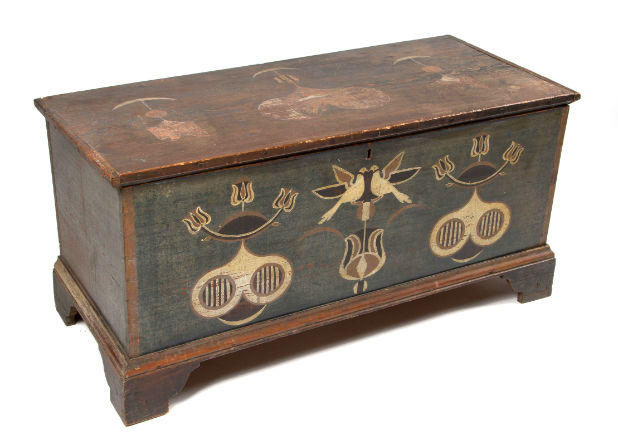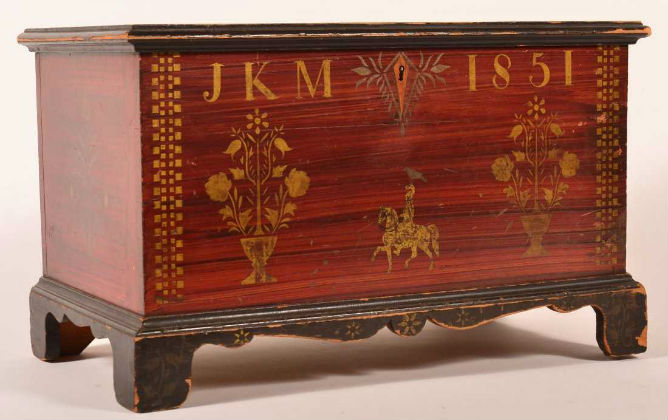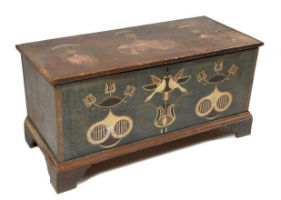
NEW YORK – American blanket chests were widely popular in the 17th through 19th centuries to store blankets, textiles and even bridal items. The form was later referred to as hope chests or bridal chests. Having a hinged top and sometimes drawers, they were practical and beautifully decorated. Today, they are highly prized by collectors more for their aesthetics than functionality and the best examples are elevated to works of art.
Jeff Evans, co-owner of Jeffrey S. Evans & Associates in Mount Crawford, Va., said blanket chests, or “chests” as they were known back in the day, can be categorized in three groups: hardwood chests, usually made of walnut, cherry or oak, and sometimes decorated with inlays or applied ornamentation; softwood (usually pine and/or poplar) that were originally painted in a simple fashion and lastly, paint-decorated chests, also often made in pine and/or poplar.
By the 18th century, blanket chests made by woodworkers and craftsmen were prevalent all over the Northeast and Mid-Atlantic states and to a lesser degree into the deep South.

“The origin of a blanket chest makes a huge difference in value. As with most vernacular furniture, Southern examples are much rarer and bring a premium price,” Evans said.
“Most New England blanket chests, which are usually taller and often referred to as mule chests, fall into the second group but some do have exuberant grain-painted decoration which makes them very desirable,” he said, explaining that most New York chests also fall into this group, and are of the standard lower form like chests from further South. There are several schools of paint-decorated chests from mainly western New York that also elicit good interest.

Chests from Pennsylvania and regions southward have been made in both hardwood and softwood and often feature elaborate decoration, especially in the folk art style emblematic of the Pennsylvania German or Dutch tradition.
Seventeenth- and early 18th-century New England oak chests are desirable if in excellent condition. However, few examples come to market that have not had extensive restorations or alterations, he explained.
“Pennsylvania German and (Shenandoah) Valley of Virginia paint-decorated chests are the most sought after and valuable. They fall into the folk art category which makes them very desirable,” Evans said.

Usually dating between 1770 and 1825, these chests are rare as well as beautiful and bring good prices from auctions or antique dealers. In June 2015, Evans sold a paint-decorated blanket chest in yellow pine made by Johannes Spitler, circa 1800, which sold for $356,500, nearly a record price for Southern furniture, topped only by a Spitler hanging cupboard that still holds the record auction price for a piece of Southern furniture at $962,500 in November 2004.
There are also a few groups of paint-decorated chests from western Pennsylvania that are very sought after, which tend to date to the 1820s-1860s. “Walnut chests with ornate wood or sulphur inlays from Pennsylvania, Maryland and Virginia are also very desirable and can bring strong prices,” Evans said.
“The most desirable chests are those that retain their original painted graphic decoration, often incorporating animals in the design. Unicorns bring big money in Pennsylvania and doves are most desirable in the Shenandoah Valley,” he said. “Many chests in German families originally contained a fraktur on the interior lid. Very few survive with the fraktur intact, and when they do they bring a premium if the fraktur is in nice condition.”

Among Southern blanket chests, ones from North Carolina, Tennessee, Kentucky, South Carolina and Georgia are also very desirable, especially paint-decorated examples, but seldom appear on market. The Museum of Early Southern Decorative Arts in Winston-Salem, N.C., has several fine examples, including a charming chest that has the look of a homemade piece, rather than one made in a cabinet shop. It retains its poplar finish but has rows of painted black dots all over its panels.
One would expect folk art museums to own blanket chests, which they do, but many other general interest museums also collect standout examples, including the Museum of Fine Arts, Boston, which has in its collection a vinegar-painted blanket chest with allover red, green, and yellow paint, molded edges and bracket feet, circa 1830-40, New England; and the Philadelphia Museum of Art, which has a circa 1860 blanket chest decorated by Edward Willis Redfield (1869-1965), made in New Hope, Pa., decorated around 1934 by Redfield with a motif of birds and flowers likely inspired by Pennsylvania German examples. The dark paint color on the chest, however, is atypical.
For collectors looking to get into this genre, condition, of course, is a major deciding factor in value. “A chest that is completely original with just normal wear will sell for up to 10 times what the same chest with restored paint, feet, etc. will sell for,” Evans said. “Average blanket chests (simply painted softwood or refinished hardwood) in today’s market can be bought for $100-$300, which makes them a great buy to just use as storage. Better examples with dry, original paint, and/or original surface generally sell in the $500-$1,000 range, with Southern examples selling a bit higher. Good paint-decorated chests can fall anywhere in the $2,500 to $250,000 range, with special examples selling for $350,000 or more.”
New collectors, however, should beware of finding old chests with newer paint that mimic the style of Spitler and Pennsylvania artists and can sometimes be offered as original pieces. Chests with enhanced paint can also be problematic. Paint-decorated chests from Europe of the period exist but do not command the same interest or prices as their American counterparts.
These striking blanket chests, once prized family heirlooms passed down from one generation to the next, are still taking pride of place in homes.



